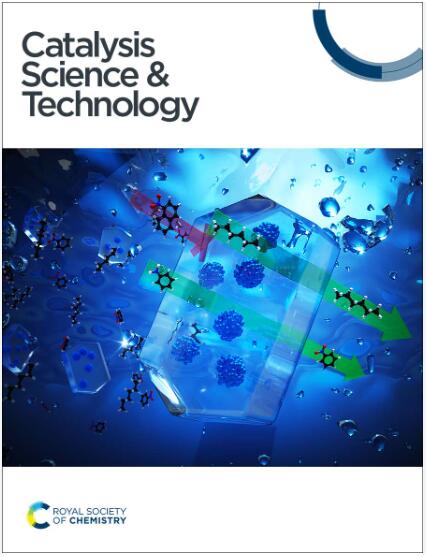氧化锆催化剂†上铂催化c12 -烷基胺加氢脱氮的研究
IF 4.2
3区 化学
Q2 CHEMISTRY, PHYSICAL
引用次数: 0
摘要
在间歇反应器中,比较了伯胺(十二烷基胺)、仲胺(二十二烷基胺)和叔胺(三十二烷基胺)在Pt/ZrO2催化剂上的加氢脱氮(HDN)。胺加氢处理的主要产物是十二烷,但在伯胺和叔胺的加氢过程中也形成了大量的仲胺作为中间体。发现伯胺是唯一可能产生直接HDN的物质;因此,仲胺的HDN通过伯胺中间体进行,叔胺的HDN涉及仲胺的形成,后者分解为伯胺。因此,叔胺和仲胺的HDN比伯胺慢。动力学模型表明,伯胺的双分子缩合反应以及伯胺和仲胺的潜在缩合反应对HDN过程有显著影响。伯胺生成仲胺提高了初始转化率和氮去除率,但似乎减慢了总氮去除率。因此,结果表明缩合反应如何影响胺HDN,这对含有脂肪胺的可再生饲料的HDN催化剂设计具有启示意义。本文章由计算机程序翻译,如有差异,请以英文原文为准。

Catalytic hydrodenitrogenation of primary, secondary, and tertiary C12-alkyl amines over a platinum on zirconia catalyst†
In this work, the hydrodenitrogenation (HDN) of a primary amine (dodecylamine), a secondary amine (didodecylamine), and a tertiary amine (tridodecylamine) over a Pt/ZrO2 catalyst was compared in a batch reactor. The main product of the amine hydrotreating was dodecane, but significant amounts of secondary amine were also formed as an intermediate during HDN of the primary and the tertiary amine. It was found that the primary amine is the only species for which direct HDN is possible; HDN of the secondary amine thus proceeds through a primary amine intermediate and HDN of the tertiary amine involves formation of the secondary amine, which decomposes to the primary amine. Consequently, HDN of the tertiary and secondary amines is slower than that of the primary amine. Kinetic modeling indicated that bimolecular condensation reactions of the primary amine, as well as potentially of the primary amine and the secondary amine, have a significant effect on the HDN process. Formation of the secondary amine from the primary amine increases the initial conversion and nitrogen removal rate but appeared to slow down the overall rate of nitrogen removal. The results thus demonstrate how condensation reactions affect amine HDN, which has implications for catalyst design for HDN of renewable feeds containing aliphatic amines.
求助全文
通过发布文献求助,成功后即可免费获取论文全文。
去求助
来源期刊

Catalysis Science & Technology
CHEMISTRY, PHYSICAL-
CiteScore
8.70
自引率
6.00%
发文量
587
审稿时长
1.5 months
期刊介绍:
A multidisciplinary journal focusing on cutting edge research across all fundamental science and technological aspects of catalysis.
Editor-in-chief: Bert Weckhuysen
Impact factor: 5.0
Time to first decision (peer reviewed only): 31 days
 求助内容:
求助内容: 应助结果提醒方式:
应助结果提醒方式:


